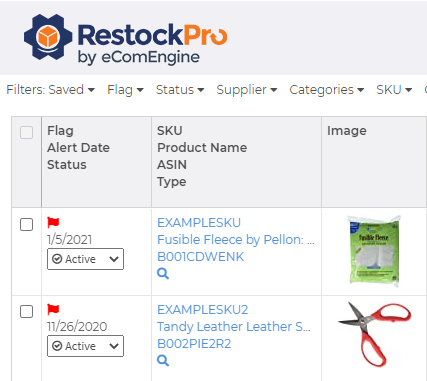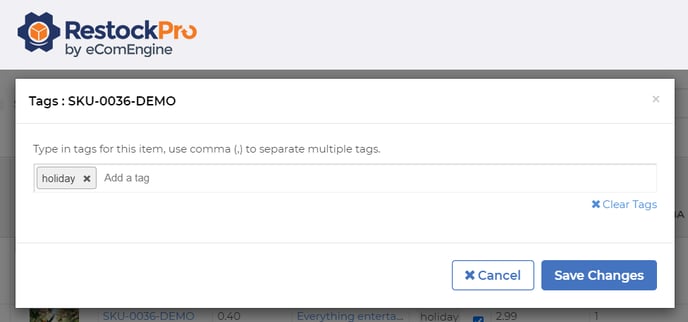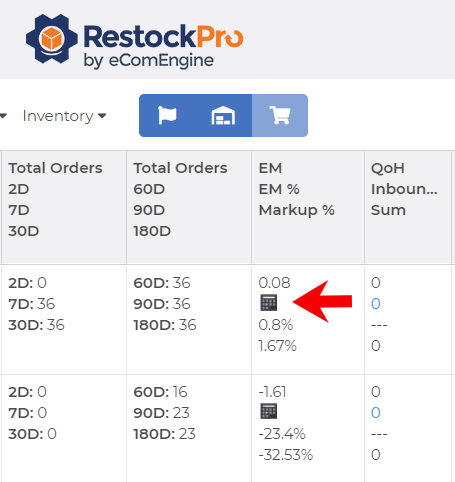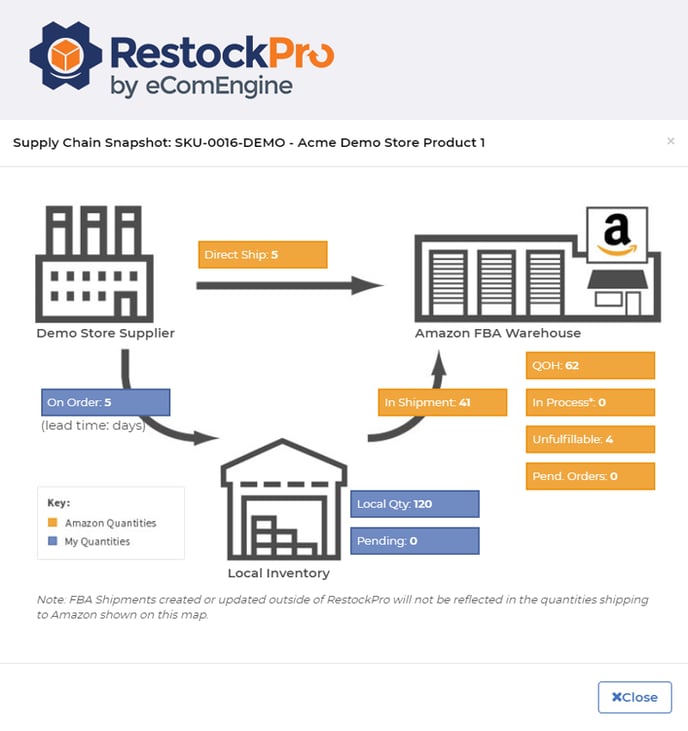In addition to seeing the suggested reorder and ship quantities and starting a PO or shipment, you can view additional information about your inventory on the Restock Suggestions page and use it to guide your business decisions.
To learn about suggested restock quantities and starting a PO or shipment, see How do I see what to restock?
Here are the other types of data shown in the main grid. Scroll down to read more about each one, or click one to jump to that section.
- Product IDs and Basic Information
- Supplier Information
- Sales and Other Financials
- Competitor Analysis
- Quantities
Note: If you can't see a data point mentioned here, you may have removed that column from your view. To add columns back to your view, click the hamburger icon toward the top right of the grid.
![]()
Product IDs and Basic Information
The Product SKU, Product Name, Image, ASIN, FNSKU, UPC, and EAN are the basic information fields related to each product. You can easily search or sort by any of these fields to find a SKU.
Tip: You can also search for products by scanning their barcodes with a Bluetooth scanner. Just scan the UPC or FNSKU barcode while your cursor is in the Search box.
There is also a magnifying glass icon on each item that lets you view product details in a pop-up modal.
Clicking the product name takes you to the listing on Amazon. Clicking the Product SKU or the ASIN will take you to the listing on Amazon or Seller Central, respectively.

Tags
Use tags to set your own product identifiers and organize your items. Click the blue tag icon to set a tag. (If you can't see the icon, trying widening the column slightly.)
To quickly set the same tag value on multiple SKUs, click the checkbox on each one and then click the blue tag. Clicking the checkbox next to the column name will multi-select every displayed product. You may enter one or more tags. Enter a comma to separate each tag.

Supplier Information
The Supplier Alias, Supplier SKU, and Cost give you your supplier info at a glance to make reordering easier.
The supplier cost shown is the one established for the product on the Products page. This cost will be used when you create a purchase order. While you create the order, the order's total cost is shown on the tile near the top right of the page.
If you have a limited inventory budget, costs can also help you decide which items to prioritize; sometimes, investing in an item that costs less is the best strategy. To learn more, read about managing profitability.
Sales and Other Financials
These fields are especially important for assessing product potential and profitability. Your Average 7-Day Price displays your average sales price over the last 7 days. Under it, you’ll see your current Listing Price.
Your Total Orders and your Velocity are shown for several time periods: two, seven, 30, 60, 90, and 180 days. Velocity is the average number of sales per day in the given time period: for example, 30-day velocity = 30-day sales divided by 30. This data is crucial to your restock plan and your decisions about SKU profitability. If a product's sales velocity is low, you may consider phasing it out of your catalog to save money and room for other items.
Estimated Margin (EM) is the estimated amount of money you can expect to make or lose on a sale. Click the calculator icon to see the details of how it is calculated.

You can track your margins even on products you have stopped selling. RestockPro helps you identify if factors have changed that should cause you to consider offering the SKU again.
Estimated Margin Percentage (EM%) is the percentage of price that is profit. Estimated Markup % is the percentage of cost that is profit.
The Referral Fee and FBA Fees are displayed in the grid and factored in automatically when calculating your estimated margin, margin %, and markup.
Competitor Analysis
Your Restock Suggestion dashboard shows you whether an item is currently being sold by Amazon directly. If Amazon begins or stops selling one of your items, this can impact your restocking decisions: you may not want to compete directly against Amazon on price.
The current new Buy Box price, the number of FBA and non-FBA sellers, and the Lowest FBA and Lowest non-FBA prices can help guide your pricing and restocking decisions to ensure you stay both competitive and profitable.
The grid also displays the category and sales rank of each SKU.
Quantities
This information shows you, at a glance, how many units of the SKU you have or are moving between various locations in your supply chain. This helps you know where all of your inventory is at all times.
Click the pin icon located in the Reserved/Unfulfillable column to display the Supply Chain Map. This is a diagram showing visually how many units are in your local warehouse, at Amazon FBA, or in transit between different locations. (See below for more on the reserved and unfulfillable quantities.)

Quantity on Hand (QOH) is the fulfillable quantity that you have on hand at Amazon FBA.
Inbound is the total quantity on its way to Amazon from either your supplier or your local warehouse. Inbound is calculated based on your inbound shipments shown on the Orders page. Inbound is broken down into Inbound Working, Shipped, and Received, based on the states of the shipments. To visualize the inbound quantities easily, click the number in the inbound field to view the Inbound Analyzer, which shows a detailed list of ship quantities that make up the Inbound Total.
Reserved and Unfulfillable are two quantities that RestockPro imports from Amazon. Reserved typically means the units are held up or moving between fulfillment centers. Unfulfillable means the units are not in saleable condition, either because of damage, expired or close to expiring dates, or some other reason.
The Pending quantity refers to the number of units included on RestockPro purchase orders, where the order is in the Pending status (has not been sent). These may be orders that are waiting for internal approval.
The Local field shows you the quantity of the SKU you have in your local warehouse, available to be shipped to Amazon. (Click Local Inventory in the top navigation for a complete view of your warehouse quantities.)
Of course, you can also see the quantities suggested for shipping and reordering. Lastly, you can see the On Order quantity, which is the quantity you have ordered from your Suppliers but which is not yet available for customers to purchase on Amazon. These units reside in open Purchase Orders in RestockPro. Click the On Order hyperlink to see the details of the orders that comprise this figure.
The Maximum Shipment Quantity is the maximum number of units of the product Amazon will allow to be stored in their fulfillment centers. Check this limit before creating a shipment.
